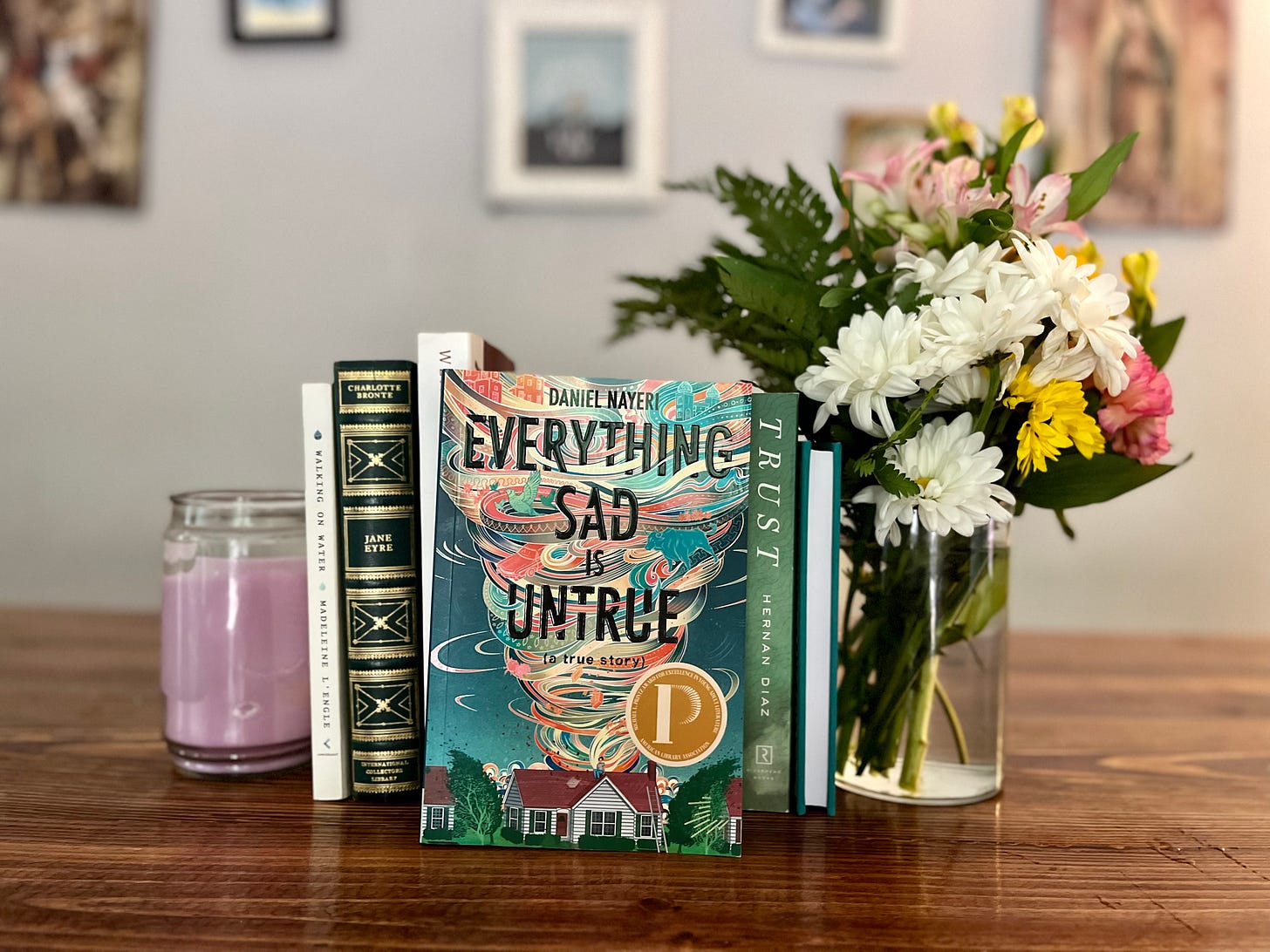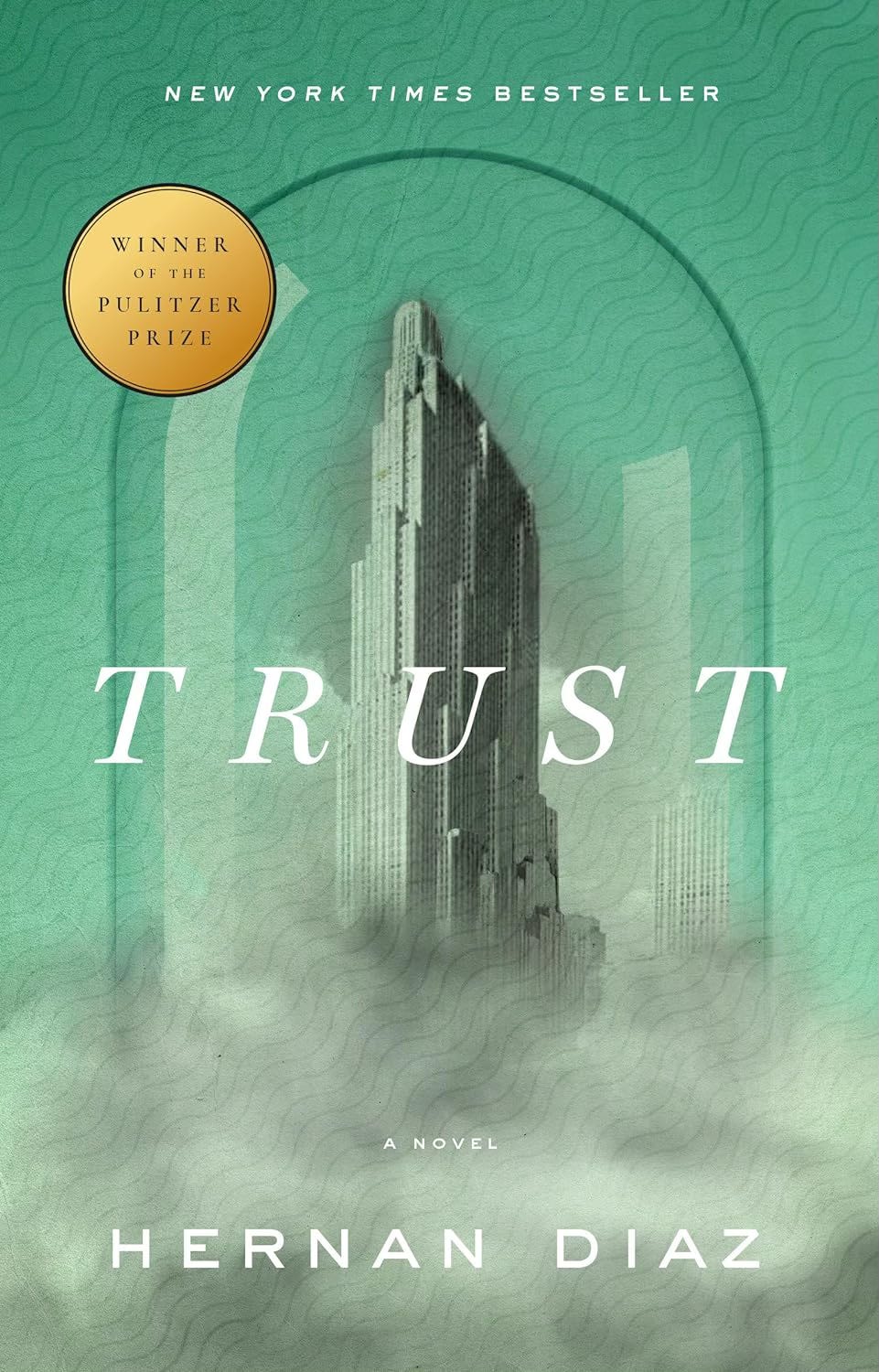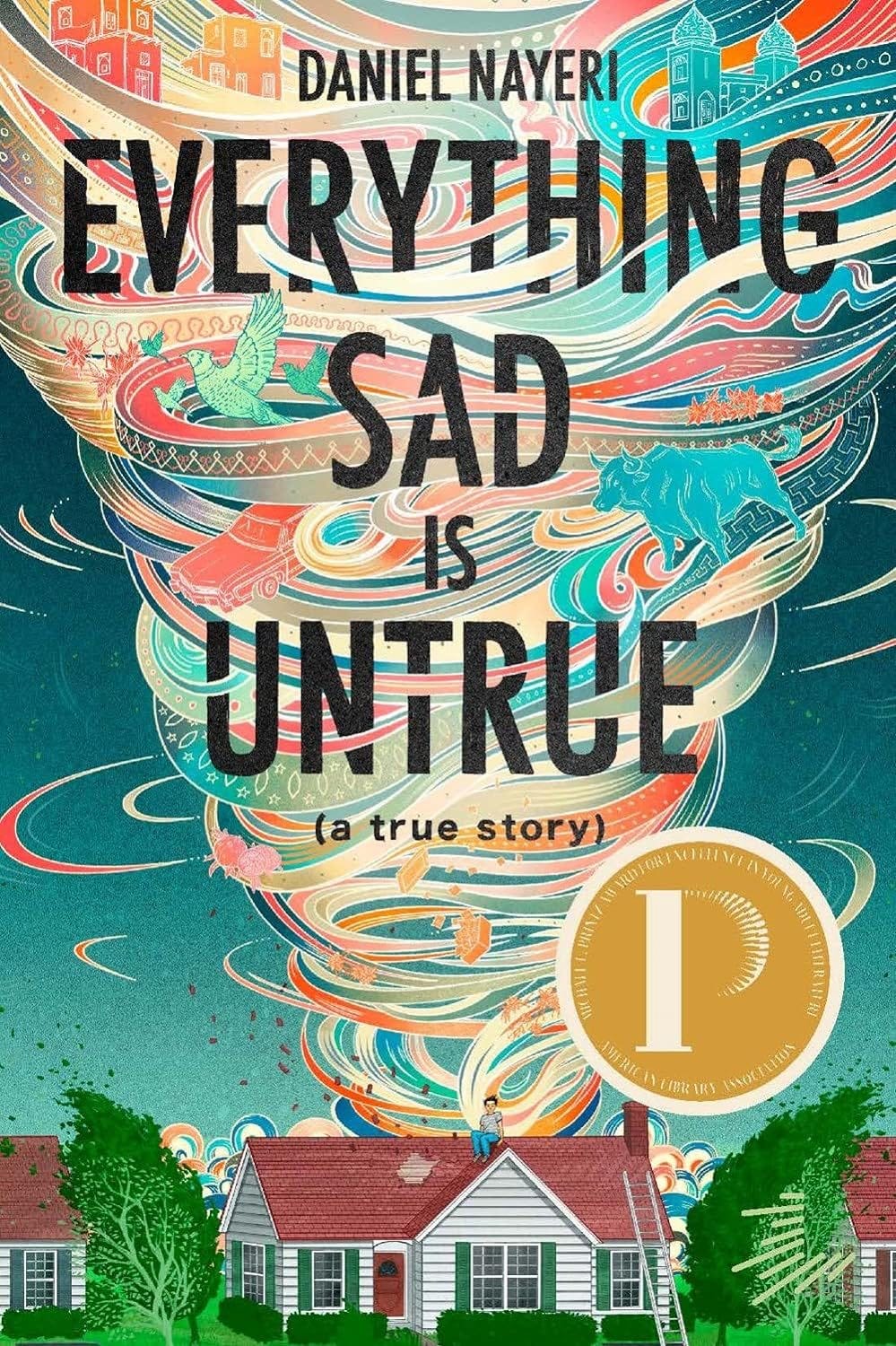Everything Sad is Untrue (pgs 1-119)
in which we muse on the power of memory and morals
All Persians are liars and lying is a sin.
Thats what the kids is Mrs. Miller’s class think, but I’m the only Persian they’ve ever met, so I don’t know where they got that idea.
My mom says it’s true, but only because everyone has sinned and needs God to save them. My dad says it isn’t. Persians aren’t liars. They’re poets, which is worse.
Poets don’t even know when they’re lying. They’re just trying to remember their dreams. They’re trying to remember six thousand years of history and all the versions of all the stories ever told. (1)
Welcome to our July book, Everything Sad is Untrue. I hope you have spent the past week enjoying this unique memoir of a novel. This is my second time reading it and I am enjoying it just as much, if not more, than I did the first time.
(yes, he is on Substack…how fun is that? An added joy to reading a contemporary author!) has such an enjoyable narrative voice and is expertly crafting this story for us. From the very first page (quoted above) we are hearing about so many of the themes yet to come.Because this is such a patchwork of a narrative I am not going to attempt any summaries in these Read Along Guides. I am choosing not to summarize partly because it would be hard AND partly because I think a linear summary would take away from the story.
With that being said, the way I am planning to structure these Read Along Guides is that I will pick a few points to muse upon that I believe are important, stuck with me, or that Nayeri seems to be hammering in. Then I will list all the other themes I think we should be paying attention to and I will let you do the work in parsing those out so that we can have good discussions at our book clubs. Each week I will leave you with a few questions to ponder as we move on to the next section of the book.
A few things before we jump in…
If you aren’t listening to the audiobook, maybe start. Nayeri reads it himself and therefore you get all of the right inflections and pronunciations, which really adds to the experience of the story.
I think it is okay if you don’t remember who everyone is. These are memories and part of the point is reflecting on the haziness of memory.
Remember, this is written en persona Daniel as a 12 year old boy. So keep in mind that we are following the memories of childhood from a child.
Alright, now let’s start…
Things to Note:
A Patchwork Story
“A patchwork story is the shame of a refugee”
(pg 37)
It is hard for me to know where to start. Which is either because I am tired OR the story is really seeping into me. Daniel seems to have the same problem. Over and over again he starts to tell a story and then stops to tell us something else. This makes the story hard to follow in some ways (or at least hard to summarize), but in another way it makes it feel like a real memory or a real story…which it is, remember? It says so right on the cover of the book! Everything Sad is Untrue (a true story).
So let’s start with that. This book is written/told in the way that memory actually works. This makes us feel like we are actually in Mrs. Miller’s classroom listening to this presentation by little Daniel. We are Kelly J (shudder). How will we respond to this fantastical story? Will we not believe it because it is has twists and turns and is sometimes dramatic? Or will we realize that this is how our memories and family history works too and let that make us more compassionate listeners?
Culture Through Stories
I am fairly certain that I could read a whole non-fiction, informational book on Iranian culture and learn so much less than I am learning from this story. Why is that? I think it is simply because I am a human. Humans learn from stories. The point isn’t to get as much information on a topic as possible, but to live the experiences another has. This happens through a story.
This book in particular is like a love letter to stories (I’m pretty sure I am loosely quoting
, so definitely thank her for that). It isn’t only one man’s stories that are teaching me and changing me, but the stories of a whole family and a whole people. We have Daniel’s stories, but also his parents’, grandparents’, and great grandparents’. Then, on top of all of that, we also have the myths and legends of his people. And, as if it couldn’t get better, we have a fictional character, Scheherazade, who is the backbone of the whole story.I am also getting an interesting mix of Nayeri showing us some Persian hospitality through the stories along with the fact that he has said we are the evil king and he is telling us stories to save his life. I’m going to keep pondering this juxtaposition as I read the next two sections.
How Fact Relates to Fiction
I cannot help harkening back to our last book, Trust, as I read the way Nayeri is telling his stories. In that book we thought about who we could trust and how history is written and by whom. In this book it is not so much that we don’t trust Daniel, but that he is openly telling us he doesn’t have all the facts. Yet, to tell a good story he will add in the made up facts he needs. Or he will say that he has heard multiple versions of the same story.
This leads me to the question I’ve been pondering: What makes a story true? Is it that all of the facts are in line with history? Or is there something deeper we should be seeking? Can a fictional story (or an edited one) convey truth as well? Can these fictional/edited stories sometimes do a better job of conveying truth?
The theme of memory also comes back to me here. Does the way that memory can almost distort reality make it an effective vehicle for truth? Is there something in human psychology assisting us with processing reality in a more story-formed way?
Lessons/Morals to the Story
One of my favorite parts of this book is Daniel’s musings on the different lessons and morals he could take from the stories he has been told and is telling.
“Honestly not everything has a lesson…” (81)
I think this is so interesting and true to life in two ways. First, the stories we read don’t always have a clear moral of the story and that is what makes them good stories. Like Flannery O’Connor says, if you want to write an essay, write as essay (paraphrase mine). When we try to make stories have a clear moral we take away from them their truly human elements.
Which brings me to my next point: the stories we tell ourselves and the memories we have are sometimes confusing. We might think we understand the moral, but then it could change. Or we are supposed to learn different things from each memory at different times in our lives. It seems like Daniel is letting us borrow his memories so we can understand his story, but also our own.
I also noticed that a lot of the morals that Daniel extracts from each story are VERY different than what I would have thought. This could be because I am very Western in my thought, but also it could be because I am an adult and he is writing from the perspective of a child. I am going to keep meditating on this as I keep reading.
Weaving of the stories together
Sometimes the way these stories are woven together can feel disorienting. But, like I said above, sometimes our memories are disorienting. I also think that Nayeri (the author) has more intention behind which stories he puts near each other than it can seem like on the surface.
One example of this is the story about Tanner’s blood then flowing into his mom getting beat up by Ray which leads to his sister saying that she only married Ray so Daniel would have a dad. Which leads Daniel to react to his classmate saying that people only marry for love by telling the story of Aziz getting married for other reasons. It helps us get to know Daniel and the mind of a child so much better while simultaneously making connections and understanding our own memories better along the way.
How the Section Ends
I realize that I broke up this book purely by page numbers, however I have been thrilled with where the sections end. It is almost like the book was meant to be broken up into three parts. Which leads me to some thoughts I will have next week on groups of threes in this book. This section ends with Daniel accidentally killing a baby owl. The book started with him being the reason for the bull’s death, a third of the way through we have the dead baby owl…will any animal die for Daniel next week? Is this theme foreshadowing any themes or the book? I think it might be…
Every story is the sound of a storyteller begging to stay alive. (59)
Themes
Storytelling/Poetry/Lies
Sin/Guilt
Dreams
Memory
Being Foreign/What is Normal
Languages
Tapestry/Rugs
Myth/Legend, Hero or History
Fatherlessness
Questions
Where is this story going to go?
Why is Daniel’s family in America?
Why isn’t his dad with them?
Are we supposed to feel slightly disoriented with all of the stories moving around in our minds? Is that how Daniel feels too?
Everything Sad is Untrue Reading Schedule
Monday, June 16th- ep. 60: Intro to Everything Sad is Untrue w/ Heidi White
Wednesday, June 18th: Introduction and Schedule
Wednesday, June 25th: pgs. 1-119 (you are here)
Wednesday, July 2nd: pgs. 119-238
Wednesday, July 9th: pgs 238-351 (but don’t forget to read the Author’s Note at the very end)
Monday, August 4th: ep. 67: Revisiting Everything Sad is Untrue
Until next time, keep revisiting the good books that enrich your life and nourish your soul.
What We’re Reading Now/Next:
June
Trust by Hernan Diaz
July
Everything Sad is Untrue by Daniel Nayeri
August
Northanger Abbey by Jane Austen
A Few Reminders:
If you are wanting to get in on the in person or virtual community please contact us!
We have turned on paid subscriptions which will allow you to support the work we are doing here as well as receive Read Along Guide PDFs each month and voice recordings of the Read Along Guides.
If you would like to make a small contribution to the work we’re doing here at Reading Revisited, we invite you to do so with the Buy (Us) a Coffee button below. We so appreciate your support!
*As always, some of the links are affiliate links. If you don’t have the books yet and are planning to buy them, we appreciate you using the links. The few cents earned with each purchase you make after clicking links (at no extra cost to you) goes toward the time and effort it takes to keep Reading Revisited running, and we appreciate it!










Love all the reflections on the relationship between memory and story. The way we sometimes shape/remember differently might sometimes, I think, convey deeper truths that the literal facts of what happened. I’ve thought a lot of the gospels, and how they are writing in such a different mode than we are used to in our western/modern culture, and that can be a hang up for people faith/belief wise when not properly understood. Finally the question of finding morals in stories/how that is a task we must be careful with dovetails very well with Northanger Abbey-it will come up a lot there too!